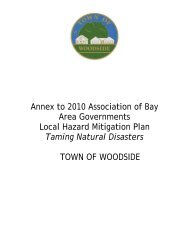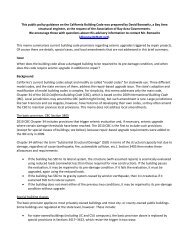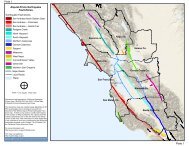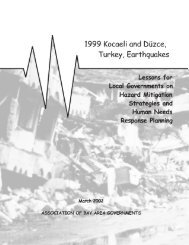Airport Liquefaction Susceptibility Analysis Report - ABAG ...
Airport Liquefaction Susceptibility Analysis Report - ABAG ...
Airport Liquefaction Susceptibility Analysis Report - ABAG ...
You also want an ePaper? Increase the reach of your titles
YUMPU automatically turns print PDFs into web optimized ePapers that Google loves.
Fugro Consultants, Inc.<br />
Project No. 04.79221200<br />
and 1970s and extended the dike to the northwest using hydraulically-placed dredged sand and<br />
gravel (the “sand and gravel dike”; URS, 2011). WLA (1999) identified at least four different<br />
episodes of fill placement and three distinct fill units:<br />
• Fill A: cohesive fill<br />
• Fill B: loose to medium dense granular fills typically derived from dredged Merritt Sand<br />
(identified as the primary liquefiable zone)<br />
• Fill C: dense to very dense granular fills<br />
The thickness of fill varies across the site inboard of the dike from roughly 8.5 to 13.5 feet in the<br />
south to between 1 and 7 feet in the north (AGS, 2008). The fill material generally consists of<br />
loose to dense sand, silty sand, medium stiff to stiff silt and clay, with variable amounts of<br />
gravel. The thickness of the clay dike fill, composed of shelly Bay Mud, ranges between 10 and<br />
20 feet. The thickness of the sand and gravel dike fill, composed of loose to medium dense<br />
sand and gravel, ranges between 15 and 30 feet. The fill bodies typically thicken to the west<br />
(WLA, 1999; URS, 2011).<br />
The dike and artificial fill are underlain by YBM, which consists of soft, sandy clay to silty clay<br />
with thin peat layers locally present. The thickness of YBM ranges from 0 to 25 feet (WLA,<br />
1999). The YBM rests unconformably on late Pleistocene to early Holocene Merritt Sand and<br />
OBM. The Merritt Sand consists of well sorted eolian sand that interfingers landward with<br />
Pleistocene alluvial fan deposits that consist of silty and sandy clay with gravely lenses. The<br />
Merritt Sand and Pleistocene alluvial fan deposits unconformably overlie OBM (Yerba Buena<br />
mud), which consists of gray marine mud (low to high plasticity clay) with some sandy and<br />
shelly horizons (WLA, 1999).<br />
4.3 Buchanan Field <strong>Airport</strong> (CCR)<br />
Buchanan Field <strong>Airport</strong> is located near the margin of Suisun Bay and the mouth of Walnut Creek<br />
in northern Contra Costa County. The airport is built on a layer of artificial fill placed over alluvial<br />
fan and estuarine sediments. The airport property is located on the distal portion of the<br />
interfingering alluvial fans of Walnut Creek and Grayson Creek where they grade into the<br />
estuarine environment of the San Francisco Bay margin. The major geologic units in the area<br />
include Holocene and Pleistocene alluvial deposits, and Holocene estuarine deposits (Figure<br />
5A; Lajoie and Helley, 1975; Helley and Lajoie, 1979, Witter et al., 2006). Maps of the historical<br />
ecology of the area show that the airport property encompasses former estuarine, moist<br />
grassland, and willow grove habitats (Figure 5B; SFEI, 2000). These habitats are characterized<br />
by tidal or shallow groundwater conditions.<br />
Aerial photography taken in 1939 (Figure 5D) shows the future airport property as farm land.<br />
The already straightened channel of Walnut Creek and the winding channel of Grayson Creek<br />
pass to the west and east, respectively, of the property. Topographic contours from show that<br />
the land slopes gently to the north, underlain by the alluvial fan deposits of Walnut Creek, and to<br />
11<br />
May 31, 2013








